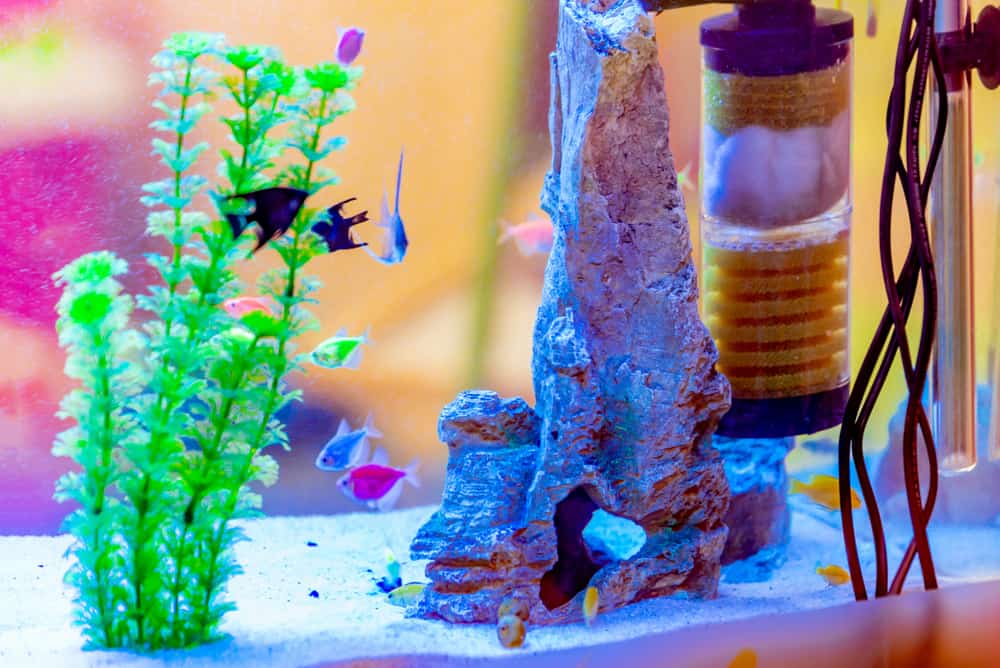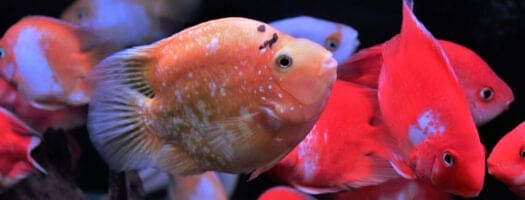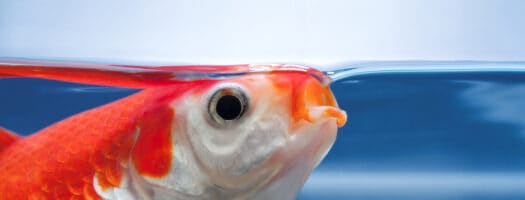The 10 Best Aquarium Canister Filters in 2026
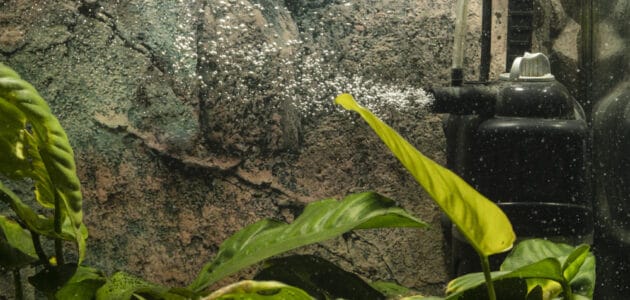
Keeping an aquarium running entails keeping it clean first and foremost, as it’s not only important you have visibility, but you also want to ensure it’s a healthy and hospitable environment. From fish to turtles, to monster squid, nobody wants a tank that’s filled with slime and grime. This is where an aquarium canister filter comes in, ensuring the water is continuously kept crystal clear. Here we’ll take a look at what filter is right for you, whether you’re an amateur hobbyist or simply keeping pets for the whole family to enjoy.
- What to Consider When Buying an Aquarium Canister Filter
- Top 10 Best Aquarium Canister Filters 2026
- 1. Best Overall Filter: Penn-Plax Cascade Canister Filter
- 2. Best Premium Filter: Fluval High Performance Aquarium Filter
- 3. Most Energy Efficient Filter: Fluval 307 Performance Canister Filter
- 4. Best Water Quality Filter: MarineLand Magniflow Canister Filter
- 5. Best Budget Filter: MarineLand Magnum Polishing Internal Filter
- 6. Best Basic Filter: SunSun 3-Stage Aquarium Canister Filter
- 7. Best Heating Filter: OASE Indoor Aquatics BioMaster Thermo
- 8. Easiest to Install: EHEIM Classic Canister Filter
- 9. Best Sterilizer Filter:: SunSun External Canister Filter
- 10. Best Compact Filter: Finnex Compact Canister
- Guide to Buying the Best Aquarium Canister Filters in 2026
- Aquarium Canister Filter FAQ
- Cleaning Up
What to Consider When Buying an Aquarium Canister Filter
When it comes to buying a filter, you ideally want the best fit, whether it’s fish for the home or showcasing animals on commercial premises. First, we’ll take a quick look at what goes into buying a filter, what makes a canister filter different than other options, and then we’ll get down to reviewing the canister filters themselves.
Canister Filter Specifications
Considering your filter’s capabilities is crucial, as you don’t want to discover last minute that the filter’s incapable of keeping up with the tank’s demands. That’s why knowing the basic terms is essential.
Gallons per Hour
You’ll find this commonly abbreviated to GPH, as it lets you know what the hourly rate of flow is on your filter and how many gallons it’s capable of filtering.
Size and Weight
Pretty self-explanatory, it’s still important you don’t overlook this one, as space is always an issue when it comes to fitting your canister filter. Not only is it essential that you install the canister, but you must also give your fish enough room to swim around happily and the tank itself also needs to sustain the weight. There’s also the case of canister or HOB, which we’ll look at further down.
Separate Canister Filter Parts
Filter Media
Media is the contents of the filter itself altering the water quality, and it can be a range of different types. There are three categories; mechanical, biological, and chemical media. You’ll likely need to refill this yourself, so make sure it’s one that’s simple enough to maintain.
Spray Bar
The spray bar works from the top of the filter, pumping water back into the tank, spraying across the surface. From this, you can maintain surface agitation, ensuring the water itself is sufficiently oxygenated.
Spillway
Like how the Spray bar works, this differs in that it acts as a waterfall, pumping the water back in from a height. These are reasonably elaborate and require more installation wise.
Extras Add-ons
Sometimes it’s vital to have add-ons and extras, especially when it comes to niche fish that may require specific conditions.
- Heaters: This is useful for making your fishy friends feel at home, as some are used to a more tropical climate. With a heater integrated into the filter, you can effectively set the water to whatever temperature you require.
- Sterilizers: These sterilize the water when it needs to be crystal clear for some more refined tastes. Usually, this means a UV bulb is included with the filter, also adding to the overall aesthetic of the canister as a whole.
- Micron Cartridge Filter: You’ll find this is used for clearing debris from the tank, keeping the water polished as well as unpolluted. Many come with their own Micron rating, which you should also take into account.
Why Are You Buying a Filter?
It may seem like an obvious question, but it’s one of the most important to consider before rushing off to make your purchase. Factors such as the amount of fish you’re keeping, as well as their breed, needs taking into account. It could even be the case that you’re planning to keep turtles, in which case you’ll need a lot more space.
The size of the tank itself needs to align with the filter. Finally, there’s the cost, and you do have some budget-friendly options, and it’s not just the upfront cost, but efficiency as well.
Now we’ll take a look at the best available canister filters you can currently buy, but we’ll also go into further detail below.
Top 10 Best Aquarium Canister Filters 2026
1. Best Overall Filter: Penn-Plax Cascade Canister Filter
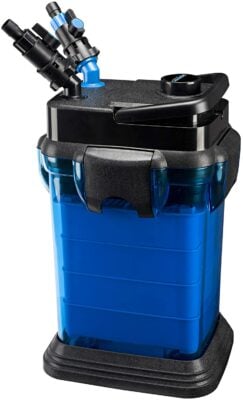
Editor’s Rating:
Why we like it: With a wide array of features, this is one of the best all-round filters from one of the most reliable brands on the market.
Quick Stats
- Size: 11.5 x 20.5 x 11 inches
- Weight: 15 pounds
- Gallons per Hour: 315 GPH
The Penn Plax name is a well-established brand from a family-owned business, so it’s no surprise that this is highly rated. Operating back to the 1950s, they’ve worked with huge companies such as Disney, creating licensed products, meaning that they’re a more than reputable source for all your aquatic needs. With the sturdy and robust build of the Cascade canister, there’s no shortage of features, as well as full control over the flow rate through its various valves.
Who’s It For?
Given that this isn’t overly expensive, it’s ideal for anyone looking for a general filter for a sizeable tank. Perfect for a family with it being easy to setup, it shouldn’t pose too much of a problem when fitting it in place. The filter itself is quiet, not causing too much of a disturbance at night, although it does use a fair amount of power, so be prepared for that.
Functionality
One downside is it can be a little fiddly to maintain, as there are no quick-release valves provided, meaning you may find a bit of excess when cleaning it out. On top of this, there’s no auto-priming, which means you must fill it manually. If you’re looking for more automated functions, then you may want to pay a bit extra for the Fluval High-Performance Aquarium Filter, but the flow valves themselves are simple enough to remove either way, and all the necessary filter media comes with it, leading to good value overall.
Pros
- Strong and sturdy build
- Filter is quiet
- Contains all required filter media
- Flow valves easy to remove
Cons
- No quick-release valves
- Lacks auto-priming
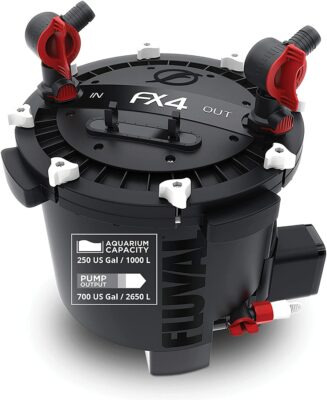
Editor’s Rating:
Why we like it: With a huge capacity and whisper quiet operation. This canister tank is our top pick for high end aquarium setups.
Quick Stats
- Size: 15.6 x 15.6 x 17.7 inches
- Weight: 14.17 pounds
- Gallons per Hour: 700 GPH
Well known for being on the high-end of the market when it comes to filters, you get what you pay for when it comes to Fluval’s FX series. Suitable for both saltwater and freshwater, it has a six-stage filtration system meaning that it’s more than capable of keeping any tank clean and crystal clear. Just be warned, it’s a powerful beast, and smaller fishes have been known to find themselves sucked up, so make sure you’re fully prepared to take it on beforehand.
Who’s It For?
Best for when it comes to larger aquariums, the FX is definitely for someone with space to spare. If you want something smaller and more compact, then the Finnex Compact Cannister might be more suited to your needs. However, this model packs in the features, ensuring that any no-nonsense aquarium owner is fully catered to, whether they’re a professional or a hobbyist.
Functionality
Long-term maintenance can take some work given the industrial standard it’s at, but it doesn’t need too much work day-to-day with its self-priming pump and multi-directional output nozzles. Extremely efficient, it auto-evacuates trapped air every twelve hours, making the most of its resources. With its high-quality parts, you don’t need to worry too much about it breaking down either, making up for the cost over an extended period.
Pros
- Self-priming Smart Pump
- Suited to both freshwater and saltwater
- Six-stage filtration
- Output nozzles are multi-directional
Cons
- Only suited to larger aquariums
- Can suck up smaller fish
3. Most Energy Efficient Filter: Fluval 307 Performance Canister Filter
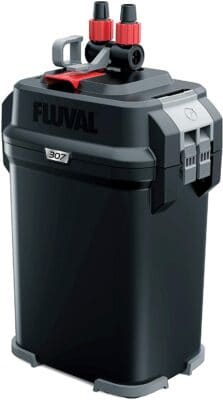
Editor’s Rating:
Why we like it: An inexpensive model not just in terms of cost, but in its overall upkeep as well, making it one of the most energy-efficient filters currently on the market.
Quick Stats
- Size: 9.5 x 7 x 16.5 inches
- Weight: 2.2 pounds
- Gallons per Hour: 303 GPH
Offering stability and durability, the Fluval proves itself as once again a reputable brand in the world of aquarium care, and this canister is no exception. The well-known Italian producer of filter canisters has crafted this particular model, which is not too expensive and energy-efficient, making it more cost-effective in the long-run. Running at just sixteen watts, the 307 doesn’t take much to keep it juiced, with previous models, including the 107 and 207, using only ten watts.
Who’s It For?
If pricing is an issue, then there’s always the Marineland Magnum, but this works out cheaper in the long-run. While some of the hoses are a little lackluster, along with a valve that could be better, the overall sturdy structure of the filter makes it ideal for extended usage. Once it’s running, it’s quiet with minimal vibrations, sustaining pressure making it perfect for the busy fish owner so that you can get on with the day-to-day hassle-free.
Functionality
Given its size and suitability for everyday tanks, it’s a shame that it doesn’t come with a standard spray-bar, which you’d expect from Fluval. You can potentially create one yourself, though, so it shouldn’t be too much of an issue, as it includes the rest of the required filter media. Working in salt and fresh water, it’s a powerful filter that does the job, providing a more long-term solution.
Pros
- Continual pressure provided
- Quiet motor and vibration-free
- Comes with complete filter media
- Powerful filter suited to both fresh and saltwater
Cons
- Flimsy hoses and low-quality valve
- No spray-bar included
4. Best Water Quality Filter: MarineLand Magniflow Canister Filter
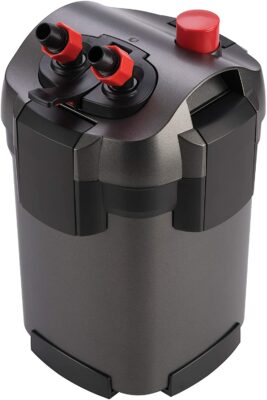
Editor’s Rating:
Why we like it: With its three-stage filtration setup, this model is perfect for cleaning all impurities out of the water, making it ideal for busier tanks.
Quick Stats
- Size: 12.2 x 9.17 x 13.62 inches
- Weight: 10.15 pounds
- Gallons per Hour: 160 GPH
As a brand, Marineland is an American business that more than knows the scene, initially having carved out their niche for aquariums in commercial spaces. Because of this, they’re adept when it comes to producing filtration systems that can handle crowded tanks. With its multi-stage filtration device, it’s a simple filter to set up and maintain, so it’s immediately ready to spring into action.
Who’s It For?
Over the years, this has been the standard brand that hobbyists will go to when filling their aquarium with various fish. That said, it stands to reason that a filter continually running at high capacity will get pretty dirty fast, and this is no exception. If you require something that maintains itself over longer periods, then the Fluval Performance Canister might be better suited, but if your aquarium is teeming with fish, then it’s Marineland all the way.
Functionality
As mentioned, its filtering system is more than adequate, with its high-quality filter that purifies and screens for dirt and debris. While it does feature a quick prime button, the tubes themselves are pretty flimsy, meaning you may need to change these over at a later date. Odors and discoloration shouldn’t be an issue either, as the black diamond carbon will go to work on this.
Pros
- Simple to set up and maintain
- Filtration device is multi-stage
- High-quality filter screening dirt and debris
- Quick prime button included
Cons
- Does require regular cleaning
- Tubes rather flimsy
5. Best Budget Filter: MarineLand Magnum Polishing Internal Filter
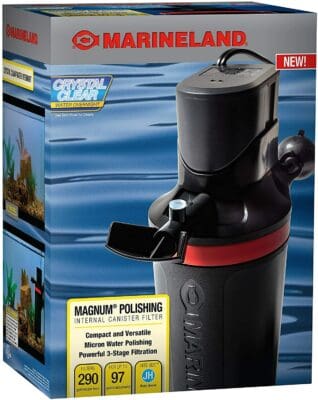
Editor’s Rating:
Why we like it: Great for low maintenance tanks, this cheap and cheerful option will tide over the casual fish owner and basic family aquarium.
Quick Stats
- Size: 8.5 x 5.81 x 11 inches
- Weight: 3 pounds
- Gallons per Hour: 290 GPH
When it comes to straight-up filter canisters, Marineland understands the market, creating simple and easy to use products. The Marineland Magnum comes with everything needed for getting started, along with all the media required for customizing its filter system. With its polisher and micron cartridge included, it keeps the water polished and free from debris taking up space and causing an eyesore.
Who’s It For?
Given its inexpensive pricing, this model could be ideal for anyone just starting and finding their way. If you haven’t much experience looking after fish, then the EHEIM Classic may be more for you with it being easy to manage. The Magniflow doesn’t take much to install, though, with its hassle-free instructions, making it ideal for beginners in the aquarium scene.
Functionality
As mentioned earlier, this model’s key selling point is its water-polisher, which helps keep the water clear and free of unsightly grit. A downside of this is that debris has to go somewhere, and it can easily clog up if left too long, and it will inadvertently let you know, making a lot of noise when it does. You may find this puts on the pressure in constantly maintaining it, but it does include plenty of media along with its polisher to ensure it more than makes up for its shortcomings.
Pros
- Hassle-free setup and installation
- Inexpensive pricing
- Micron cartridge for polishing included
- Customize the media with its versatile filter system
Cons
- Can get loud when unclean
- Easily clogs up
6. Best Basic Filter: SunSun 3-Stage Aquarium Canister Filter
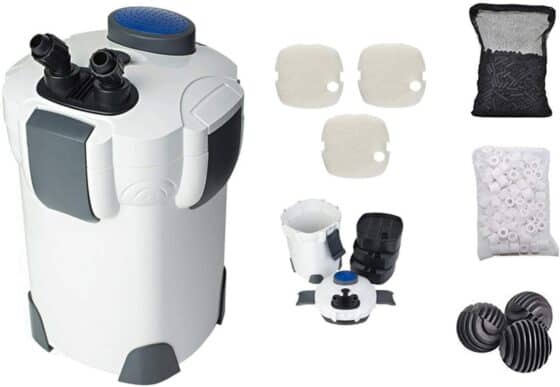
Editor’s Rating:
Why we like it: Simple to set up and manage, this filter is ideal for the everyday fish owner, although it does have some useful extras packed in too.
Quick Stats
- Size: 9 x 9 x 15 inches
- Weight: 2.98 pounds
- Gallons per Hour: 264 GPH
As a company, SunSun is making headway fast in the world of aquarium filters, being a relative newcomer to the game. This cheap and easy to manage filtration system is a good sign of things to come, being a stripped-down canister filter with a few bonuses. With its UV bulb for killing bacteria, it’s safe and effective for keeping your tank clean and spore free.
Who’s It For?
There’s not much to this filter, as it offers the bare essentials necessary for managing the average aquarium. Inversely there are filters with functions galore, such as the Fluval High-Performance, but this isn’t that. It’s a filter that’s ideal for the everyday fish owner who has a casual interest, with it providing three media trays and a self-priming pump, you to get on with the day-to-day.
Functionality
While you can look online for help with the installation, it’s still a burden when setting up, made all the more difficult through its poor instructions. It does have a spray-bar, but it’s high up, meaning it’s a little cumbersome when placing it, making for more difficulties when installing it. That said, it does provide versatility when it comes to using media, which you can buy in bulk, meaning it’s a little cheaper to manage.
Pros
- Three media trays included
- Comes with a UV bulb killing bacteria and spores
- Self-priming pump included
- Versatile with media being available in bulk
Cons
- Its spray-bar is high up
- Installation is tricky with little instruction
7. Best Heating Filter: OASE Indoor Aquatics BioMaster Thermo
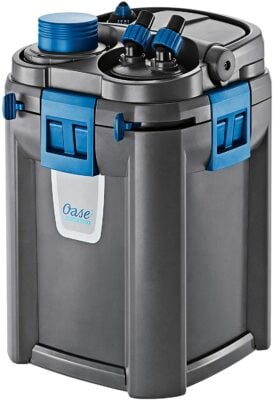
Editor’s Rating:
Why we like it: This particular filter has the bonus of ensuring that the tank is set to the ideal temperature, making sure it’s just right for any specialty fish.
Quick Stats
- Size: 9.4 x 9.4 x 14.6 inches
- Weight: 15.5 pounds
- Gallons per Hour: 250 GPH
Well designed with a robust frame, OASE has been making a strong impression on hobbyists and aquarium enthusiasts. The BioMaster is an excellent example of what they have to offer, even if it is on the pricier side, with its integrated heater and four-stage filtration system all-in-one. Needing little maintenance and minimal upkeep, it fits in quietly, making for a high-quality filter system.
Who’s It For?
Perfectly fitting marine and freshwater aquariums, this is the ideal setup for any hobbyists with a fish collection with specific requirements. There are other systems geared towards specific needs, such as the SunSun External, which provides a sterilizer, but the BioMaster is one of the few with a heater. Because of this, it’s perfect for replicating the natural habitat and conditions of most fish swimming out in the wild.
Functionality
It comes with a priming pump built-in, so it does do a lot of the work for you. There’s a flow regulator, too, allowing you to adjust the water flow to whatever you need. On the downside, it’s known to purge a lot of air, sometimes continuously, sending bursts of air bubbles into the tank, but OASE themselves have acknowledged this and are supposed to be looking into it.
Pros
- In-built priming pump
- Quiet and easy to maintain
- Integrated heater
- Four-stage filtration system
Cons
- Very expensive
- Often purges air
8. Easiest to Install: EHEIM Classic Canister Filter

Editor’s Rating:
Why we like it: This is one filtration system that doesn’t pose any problems when setting up, making for an effective and easy to manage canister filter.
Quick Stats
- Size: 11 x 7.28 x 14.57 inches
- Weight: 6.07 pounds
- Gallons per Hour: 164 GPH
Classic in name and classic in design, the external filter from EHEIM has a sturdy and robust frame that’s as well known for its efficiency as it is for its usability. Everything is included for instantly getting it up and running, and it’s energy-efficient, too, to the point of potentially lasting several hours of a basic UPS during a power outage.
Who’s It For?
The EHEIM is one of the most accessible filters we reviewed. While its range is somewhat limited when it comes to finding aquariums that fit, you don’t need much to install it and keep it running. Therefore, the filter is perfect for someone without a great deal of technical skill, although you do need to clean out the media fairly often, as there’s no bypass, keeping the water a lot clearer in the long run.
Functionality
One notable factor that the EHEIM has going for it is its high-capacity for holding plenty of media. There’s a better water flow rate through the filtration media itself without any media trays, leading to far clearer water. One downside to it, unfortunately, is there’s no self-priming included, meaning you’ll need to keep up with it yourself, which is a shame given how simple the rest of the setup is.
Pros
- Robust and reliable water pump
- A lot of room for media with no trays
- Everything required for instant start-up
- Highly energy efficient
Cons
- Lacks an instant primer
- Limited range of aquariums
9. Best Sterilizer Filter:: SunSun External Canister Filter
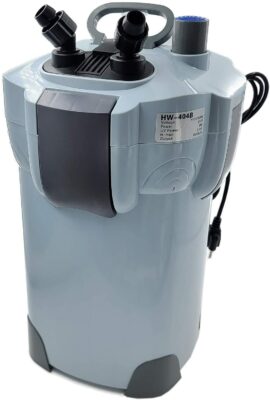
Editor’s Rating:
Why we like it: Ideal when you need to maintain the water quality, keeping it sterile and safe for your more delicate aquatic friends.
Quick Stats
- Size: 20 x 16 x 14 inches
- Weight: 17.15 pounds
- Gallons per Hour: 525 GPH
One of the first things you’ll notice with this filter is that it’s reasonably sizeable and weighty, taking up a considerable amount of space. It does pack a lot of power, though, with its biological and chemical filtration making sure to keep the tank clean to the point of being sterile. With its nine-watt UV sterilizer built-in, it may seem better suited to larger tanks, but it’s surprisingly adaptable to a range of different aquariums.
Who’s It For?
This filter is best suited to those with specific needs when keeping rarer breeds of fish, with its highly capable sterilizer. We like that it’s not too expensive either. It’s accessible to a broad market of more casual users, not keeping it solely for the experts.
Functionality
It could ideally offer a less brittle intake tube, meaning it may take a fair amount of upkeep. The tubes are also loosely fitted, which can cause problems with leakage, but the rest of the filter is pretty sturdy and stable. It’s not too difficult to clean out either.
Pros
- Nine-watt UV sterilizer built-in
- Self-priming pump included
- Simple to clean
- Robust and sturdy
Cons
- Tubes are a little flimsy
- Loosely fitted, making way for leaks
10. Best Compact Filter: Finnex Compact Canister
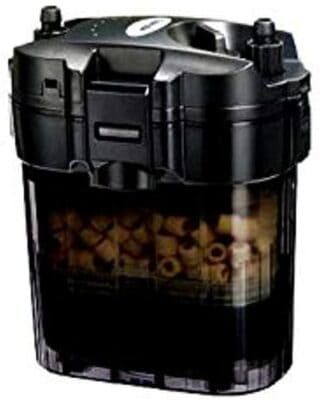
Editor’s Rating:
Why we like it: A tightly contained unit that’s ideal for an equally tight fit, slotting neatly beside smaller tanks and quietly doing its job.
Quick Stats
- Size: 4.8 x 7.2 x 8.1 inches
- Weight: 1.58 pounds
- Gallons per Hour: 95 GPH
Easily fitting on to the tank, you can use this versatile compact filter as either a canister or you can hang it on the back of the aquarium. Aimed at smaller tanks, this provides everything needed for the modern aquarium, with detailed instructions that make it simple to setup. Whether it’s fish or turtles you’re keeping, this can take a surprising amount of pressure, with its above-average water flow.
Who’s It For?
Perfect for keeping turtles, this allows for a considerable amount of space in the tank itself, especially if the aquarium is smaller in size. If cost is an issue, then the Marineland Magnum is also relatively small and inexpensive. Providing a clear and unobstructed view of any fish or turtles, it’s ideal for showcasing your pets, making a great addition to any family home.
Functionality
Before you begin, you probably want to get different inflow and outflow tubes, as the ones provided leave a lot to be desire, with the potential for leakage. There’s also an issue with air purging, as it can suck up air, causing some trouble if not maintained. You do get a spray-bar and spray nozzle, though, along with good water flow, making it a lot easier to manage in this department.
Pros
- Great for small tanks
- Water flow is excellent
- Spray Bar and Spray Nozzle included
- Detailed instructions provided
Cons
- Can leak on occasion
- Air purging is an issue, sometimes sucking in air
Guide to Buying the Best Aquarium Canister Filters in 2026
A lot goes into purchasing an aquarium canister filter, so you need to weigh all your options before committing yourself to anything. Here we’ll take a closer look at the canister itself, what it means, and how you can make yours last even longer.
What Exactly Is a Canister Filter?
So, first things first, you want to familiarize yourself with the aquarium canister filter and what it can offer you. Simply put, the canister filter takes the water from the aquarium and sieves it through a series of media filters found within the pressurized canister, and then pumps it back out, either using a spillway or spray bar. The main benefit of using a canister filter as opposed to other types of aquarium filters is that canister filters often make much less noise.
The filter pumps the water from the tank, using tubes to draw the water in through the canister and back out again. There are many variations to this, with some implementing different add-ons, as we shall see, but the filter itself is the core part of it.
Filter Cleaning and Maintenance
Keeping your canister filter well maintained is essential, as you don’t want it immediately breaking down, especially when the life of your fish depends on it! While there are some more in-depth video guides out there, here are some quick cleaning pointers to help get you started:
- Shut Everything Off and Prepare the Area: First, turn off the filter, making sure there’s no electricity on, followed by shutting off the valves and unscrewing the tubes. Then you need to transport it to an area with plenty of room, and plenty of towels, as it’s going to get wet!
- Remove the Housing and Insides: depending on where they are, locate and release the locks around the canister’s housing on both the motor and the insides, carefully removing it and setting it aside. Let as much water drain before installing the filter and use the towels to catch any excess.
- Clean the Filter: it’s best to use a sink here, as you hose the filters down now. You then want to use a scrubbing pad, although an old toothbrush is ideal for the fiddly bits, and work at all that slime and algae that’s been building up. Keep rinsing, as there’ll be mounds of excess grime.
- Remove and Clean the Impeller: This is delicate work, so you must be careful, and it’s best to use a toothbrush to reach those tricky corners, removing the gunk gently. Wipe the hole, too, cleaning it with a q-tip, removing all resistance before putting it back together.
- Clean the Canister: You’ll need to remove the media trays here, making sure to get rid of all excess water. It’s essential to work quickly now, as you could be losing vital bacteria in the oxygen. Then rinse out the inside of the canister, wiping out all the grit and grime.
- Reassemble and Turn on: Fitting it all back into place, you can lock everything down, including the housing and motor, before fastening the tubes and valves, making sure not to screw too tightly. Then, turn the valves to ‘on’ and filling it up before plugging it in and switching it all on.
You can usually schedule cleaning the filter around your own schedule. You don’t want to leave it too long, though, as not only will the fish be swimming in their filth, but you’ll find yourself having to buy a whole new canister.
Practicality and Aesthetics
When it comes to how your aquarium will look, you’ll have to weigh between being practical and it looking good. You may have set up a sight to behold with a fantastic spillway that wows visitors, but it’s going to be difficult if you’re always cleaning it out. There’s also no point in having it look excellent if you’re storing livestock in the back of commercial premises.
While all of this may seem obvious, you must consider what your aquarium’s purpose is going to be, as this will dictate a large part of it.
Canister vs. HOB
The ‘hang on back,’ or HOB filter as it’s more commonly known, is a filter that simply does what it says and hangs on the back of the aquarium. While canisters sit either beside or in the tank, HOBs use a small pump and a water lift tube. There are some filters that do both, but, for the most part, you’ll need to decide which is best for you.
Price is usually one of the defining features, with the HOB typically being a lot cheaper. Then there’s the installation and maintenance, with canisters placing a higher demand on the user. When it comes down to it, though, HOB filters are usually better for smaller personal tanks. Alternatively, canisters are more professional, giving more in the way of functionality and water quality.
Tips for Installing
Getting yourself setup, installing your canister filter, and fitting it in place is a significant part of the process. Here we’ll take a brief look at that:
- Start With the Manual: While this may seem obvious, this is the best place to start, as every filter will differ. You should also find installation videos online of the individual models, showing you how to fit the specific parts.
- Collect the Parts Together: Lay everything out, making sure you have the room. Then take inventory, making sure nothing’s missing.
- Canister Assembly: First, taking the canister and opening it out, checking all the filtration media is correctly in place. This process may vary depending on the canister itself. Rinsing it out, you can clear it of any dust before fitting it together.
- Placing the Canister: This needs to consider both the practical application of the filter and how it looks. Test it out, making sure it’s easy to remove when necessary while also not obstructing the view, and being close enough to plug in everything.
- Fitting the Hoses: There are two hoses, with one pumping water into the filter, and the other pumping it back out. You don’t want to screw these too tightly, as mentioned earlier, as you’ll end up causing leaks later on.
- Priming and Managing the Air: Once the canister is all together, you need to make sure it’s filled with water before switching it on. Most basic canisters have a self-primer you can use, but if not, you’ll need to suck on the siphon hose to make sure it’s filled completely.
- Making Adjustments: This will include adjusting the intake screen along the bottom of the tank while ensuring the filler return tube is in the right place. You may have a spray bar, in which case you want to allow it to give good coverage of the water surface.
Take your time over each step, as it would be annoying to have to pull everything back out of the tank due to a misplaced part. You want to make sure it’s working at maximum efficiency, meaning less work in the long run.
Aquarium Canister Filter FAQ
How Long Do Canister Filters Last?
It’s usually the case that a good filter canister will last a long time, with some running between fifteen and twenty years on average. Obviously those of better quality will last longer, but it also depends on how well you take care of it. From the motor to the filter media, you can find new parts for it whenever necessary.
How Can I Make My Canister Filter Quieter?
If a filter is being excessively loud, it usually means there’s an issue with the pump. If this is the case, take it all apart, seeing whether there’s any dirt before replacing anything. It could just be that something has been sucked into the filter, which means it needs removing. You can also lower the water flow rate, as you don’t place too much stress on the filter, but equally don’t have it too low because this will pollute the tank.
Which Is Better, Canister Filter or Sump?
Some may choose to have a sump as opposed to a canister filter, which all depends on the user’s needs. A sump filter may offer more versatility in many ways, but a canister is often more accessible. It can also come down to water coverage and the tank’s layout, so plan how everything will ideally fit in place.
Can You Use a Protein Skimmer With a Canister Filter?
The protein skimmer can be useful for many reasons, most notably its ability to remove waste and excess food from the tank. Usually, many use a skimmer alongside a sump, although you can use it with a canister too, and if you have reefs, they’re essential. If you do have it with a canister filter, you must make sure you clean it out regularly.
Cleaning Up
It’s always important to keep in mind that your aquarium’s water can never be too clean. While you don’t want to overdo it as you can only depollute it so much, making sure the GPH is high is one of the best places to start. Once you have it all in place, you’ll then have a happy and healthy tank, which will not only be great for you but will please your fish as well, and this is what it’s really all about.
